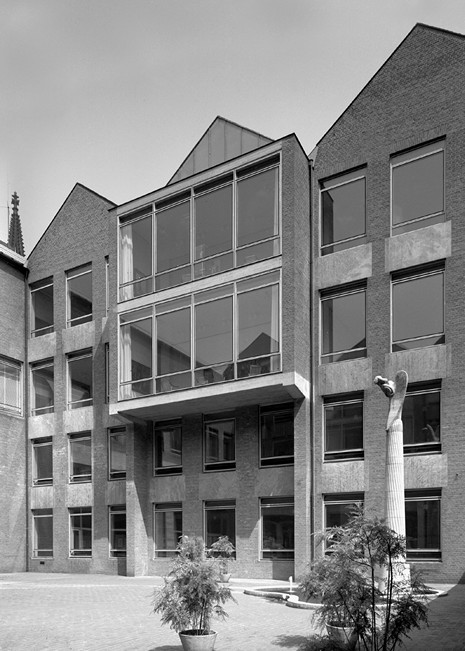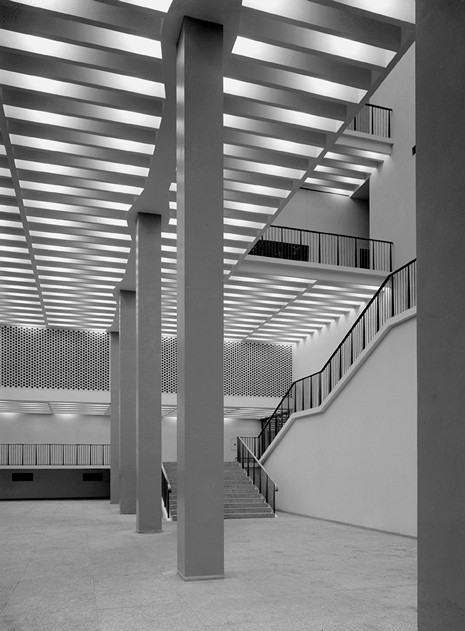Description
The Wallraf-Richartz-Museum, Cologne’s picture gallery, was the first large museum to be built in Germany after the Second World War. Rudolf Schwarz replaced the nineteenth century building that had been bombed out with a three-winged volume that traces the ground plan of the former Franciscan monastery and surrounds an inner courtyard where the fragmentarily conserved cloisters are located, and on whose south side rises the Gothic Minorite church, setting the proportions. The unpretentious brick architecture is characterized by its articulation in six bays running parallel to the Minorite church, each of them with a gable roof. Thus, the east and west sides resemble the fronts of narrow, gable-crowned houses set in a row – an allusion to the historical structural fabric, but justified primarily functionally by the architect. The rhythm of the windowed and closed façade sections and their alternating crowning by blind gables and gables of glass resulted mainly from the intention to illuminate the exhibition rooms alternately with side light and top lighting; even the glazing of the gables prevents shadows on the illuminated ceilings. The stacked up supporting pillars on the largely closed northern façade are probably an allusion to the buttresses of the mediaeval ecclesiastical buildings. Apart from their articulating function, the pillars also fulfil a real structural function, as the supporting brick walls are not stabilized by any reinforced concrete constructions.
The interior, which one accesses through a discreetly-placed entrance on the north side, opens into a grand hall, itself opening onto the courtyard dominated by a flight of steps articulated by a number of half-landings and leading up to the main floors of the museum. Rooms of varying sizes, with ceilings of different heights and with varied lighting arrangements surround and interpenetrate each other – although they are arranged essentially in straight lines – whereby Schwarz, as the “most natural” lighting favoured the side light falling in from windows and expressly distanced himself from any “effect lighting.” It was above all the explosive growth of twentieth century artworks from the Stiftung Ludwig that led in 1986 to the transfer of the picture gallery to a new building. After a sensitively carried out restoration, the building, in the meantime extolled as a classic of museum architecture, has proven to be a surprisingly suitable domicile for Cologne’s Museum of Applied Arts.
Bauen + Wohnen 1954, pp. 6-8 • Glas Forum 5/1957, pp. 8-15 (Otto Völckers) • Baukunst und Werkform 11/1958, pp. 5-12 (Hannelore Schubert) • Die Bauzeitung 64/1959, pp. 134-139 (Harbers) • Mathias Schreiber (ed.), 40 Jahre Moderne in der Bundesrepublik, Stuttgart, 1986, pp. 35-37 • Hannelore Schubert, Moderner Museumsbau, Stuttgart, 1986, pp. 38-40 • Kunstchronik 43/1990, pp. 111-123 (Barbara Mundt) • Wolfgang Pehnt/Hilde Strohl, Rudolf Schwarz, Stuttgart, 1997, pp. 169-175, pp. 270-272
Drawings
Ground floor
Second floor
North-south section
East-west section
Photos

View of the southwest corner of the inner courtyard, 1957

View of the hall with stairway
Originally published in: Paul von Naredi-Rainer, Museum Buildings: A Design Manual, Birkhäuser, 2004.